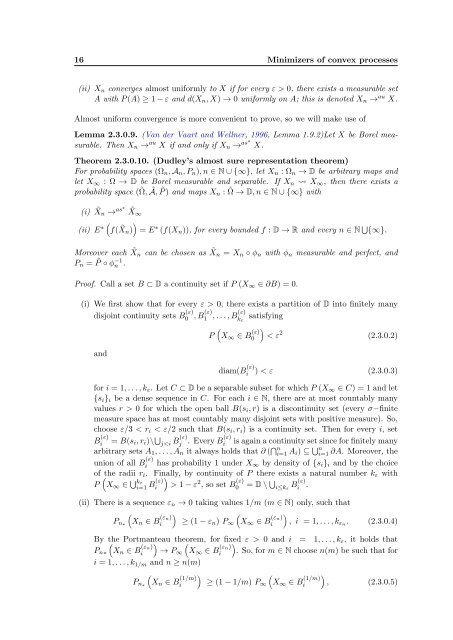Subsampling estimates of the Lasso distribution.
Subsampling estimates of the Lasso distribution.
Subsampling estimates of the Lasso distribution.
Create successful ePaper yourself
Turn your PDF publications into a flip-book with our unique Google optimized e-Paper software.
16 Minimizers <strong>of</strong> convex processes<br />
(ii) X n converges almost uniformly to X if for every ε > 0, <strong>the</strong>re exists a measurable set<br />
A with P (A) ≥ 1 − ε and d(X n , X) → 0 uniformly on A; this is denoted X n → au X.<br />
Almost uniform convergence is more convenient to prove, so we will make use <strong>of</strong><br />
Lemma 2.3.0.9. (Van der Vaart and Wellner, 1996, Lemma 1.9.2)Let X be Borel measurable.<br />
Then X n → au X if and only if X n → as∗ X.<br />
Theorem 2.3.0.10. (Dudley’s almost sure representation <strong>the</strong>orem)<br />
For probability spaces (Ω n , A n , P n ), n ∈ N ∪ {∞}, let X n : Ω n → D be arbitrary maps and<br />
let X ∞ : Ω → D be Borel measurable and separable. If X n X ∞ , <strong>the</strong>n <strong>the</strong>re exists a<br />
probability space (˜Ω, Ã, ˜P ) and maps X n : ˜Ω → D, n ∈ N ∪ {∞} with<br />
(i) ˜X n → as∗ ˜X∞<br />
(<br />
(ii) E ∗ f( ˜X<br />
)<br />
n ) = E ∗ (f(X n )), for every bounded f : D → R and every n ∈ N ⋃ {∞}.<br />
Moreover each ˜X n can be chosen as ˜X n = X n ◦ φ n with φ n measurable and perfect, and<br />
P n = ˜P ◦ φ −1<br />
n .<br />
Pro<strong>of</strong>. Call a set B ⊂ D a continuity set if P (X ∞ ∈ ∂B) = 0.<br />
(i) We first show that for every ε > 0, <strong>the</strong>re exists a partition <strong>of</strong> D into finitely many<br />
disjoint continuity sets B (ε)<br />
0 , B(ε) 1 , . . . , B(ε) k ε<br />
satisfying<br />
(<br />
P X ∞ ∈ B (ε) )<br />
0 < ε 2 (2.3.0.2)<br />
and<br />
diam(B (ε)<br />
i ) < ε (2.3.0.3)<br />
for i = 1, . . . , k ε . Let C ⊂ D be a separable subset for which P (X ∞ ∈ C) = 1 and let<br />
{s i } i be a dense sequence in C. For each i ∈ N, <strong>the</strong>re are at most countably many<br />
values r > 0 for which <strong>the</strong> open ball B(s i , r) is a discontinuity set (every σ−finite<br />
measure space has at most countably many disjoint sets with positive measure). So,<br />
choose ε/3 < r i < ε/2 such that B(s i , r i ) is a continuity set. Then for every i, set<br />
B (ε)<br />
i = B(s i , r i )\ ⋃ j 1 − ε 2 , so set B (ε)<br />
0 = D \ ⋃ i≤k ε<br />
B (ε)<br />
i .<br />
(ii) There is a sequence ε n → 0 taking values 1/m (m ∈ N) only, such that<br />
(<br />
P n∗ X n ∈ B (εn) )<br />
(<br />
≥ (1 − ε n ) P ∞ X ∞ ∈ B (εn) )<br />
, i = 1, . . . , k εn . (2.3.0.4)<br />
i<br />
By <strong>the</strong> ( Portmanteau <strong>the</strong>orem, for fixed ε > 0 and i = 1, . . . , k ε , it holds that<br />
P n∗ X n ∈ B (εn) ) (<br />
i → P ∞ X ∞ ∈ B (εn) )<br />
i . So, for m ∈ N choose n(m) be such that for<br />
i = 1, . . . , k 1/m and n ≥ n(m)<br />
(<br />
P n∗ X n ∈ B (1/m) )<br />
(<br />
≥ (1 − 1/m) P ∞ X ∞ ∈ B (1/m) )<br />
, (2.3.0.5)<br />
i<br />
i<br />
i
















